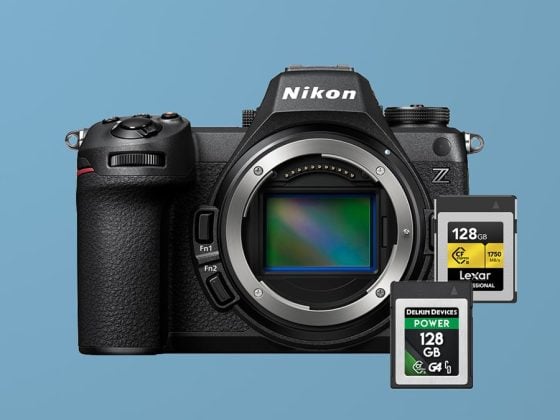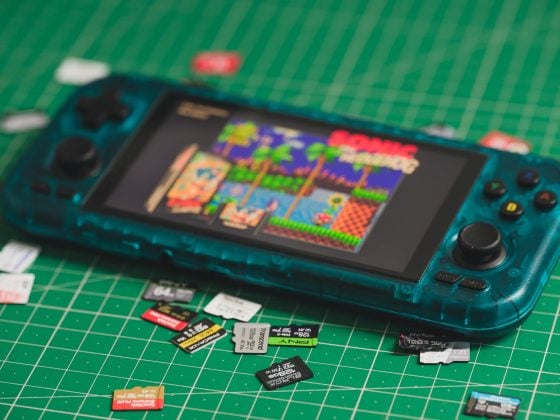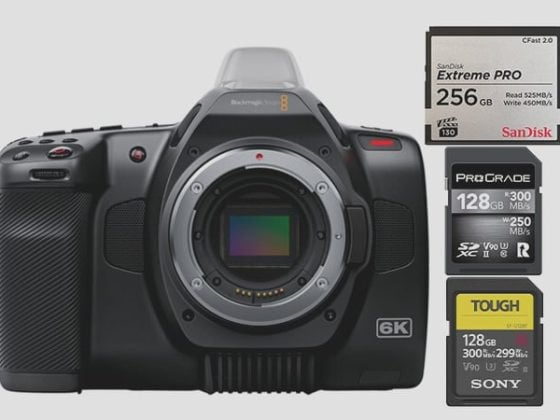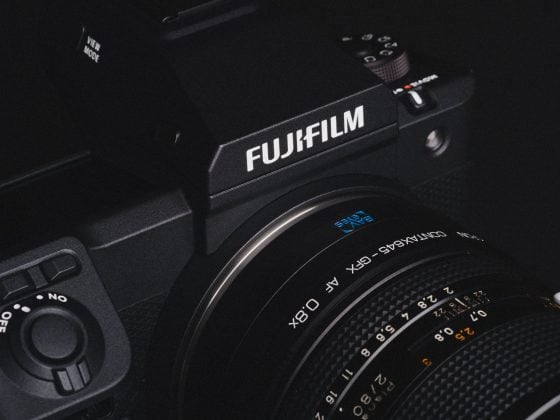The ultimate guide to the best and most reliable memory cards for the DJI Osmo Action. I’ve tested each microSD memory card in the camera to see which cards perform the best.
I’ve also Included the official list DJI has been recommending for their devices as well as my top five recommendations, with a few cards that aren’t on their list.
Best Memory Card DJI Osmo Action
To measure the performance of each microSD memory card in the Osmo Action, I was able to measure the speed at which the camera could clear the buffer when shooting a burst of photos.
With the faster cards, the camera was ready to shoot a second or two sooner than the slower cards. Not a big deal, but it at least shows us what cards are working better in the Osmo Action.
| Recommended Cards | Speed Class | Check Price | |||||
|---|---|---|---|---|---|---|---|
| UHS-II | |||||||
| Lexar 1800x V60 | UHS-II | ||||||
| Lexar 1000x V60 | UHS-II | https://amzn.to/4aPV7AV | Amazon | ||||
| Lexar Gold V60 A1 | UHS-II | https://amzn.to/4bagtcJ | https://bhpho.to/4aHLcNP | Amazon / B&H | |||
| ProGrade V60 | UHS-II | https://amzn.to/4efEe5z | https://bhpho.to/3WcNkWC | Amazon / B&H | |||
| Delkin Power V90 | UHS-II | https://amzn.to/4ehxrbU | https://bhpho.to/3jYArSz | Amazon / B&H | |||
| Angel Bird A1 V60 | UHS-II | https://amzn.to/4aTemcP | https://bhpho.to/3KvGqrW | Amazon / B&H | |||
| UHS-I | |||||||
| Sandisk Extreme Pro U3 A2 | UHS-I | https://amzn.to/3L2CpvE | Amazon | X | |||
| Sandisk Extreme Plus U3 A2 | UHS-I | https://amzn.to/3wXFI3O | https://bhpho.to/3kaVa5S | Amazon / B&H | X | ||
| Sandisk Outdoors 4k V30 A2 | UHS-I | https://amzn.to/3VdRL5e | https://bhpho.to/3V2xAah | Amazon / B&H | |||
| Sandisk Extreme U3 A2 256GB-1TB | UHS-I | https://amzn.to/45fAa17 | https://bhpho.to/3VB2UNB | Amazon / B&H | |||
| Sandisk Extreme U3 A2 128GB | UHS-I | https://amzn.to/3Vo6X0C | https://bhpho.to/3QyhZMU | Amazon / B&H | X | ||
| Sandisk Ultra U1 A1 | UHS-I | X | |||||
| Sandisk Nintendo Switch V30 A1 | UHS-I | https://amzn.to/3VgdGJ1 | https://bhpho.to/3GDbYtR | Amazon / B&H | |||
| Sandisk High Endurance V30 | UHS-I | https://amzn.to/45czB8x | https://bhpho.to/3CJlQRs | Amazon / B&H | |||
| Sandisk Max Endurance V30 | UHS-I | https://amzn.to/3VgdJEH | https://bhpho.to/3CGD9Tk | Amazon / B&H | |||
| Samsung Pro Ultimate v30 A2 | UHS-I | https://amzn.to/3ViNnSa | https://bhpho.to/3ZEJ1GO | Amazon / B&H | |||
| Samsung Pro Plus V30 A2 | UHS-I | https://amzn.to/4bV6oS6 | https://bhpho.to/3VxG5LT | Amazon / B&H | X | ||
| Samsung EVO Plus V30 A2 | UHS-I | https://amzn.to/3Kz3mGP | https://bhpho.to/3WZtaDE | Amazon / B&H | X | ||
| Samsung EVO Select V30 A2 | UHS-I | https://amzn.to/3x8DtL3 | https://bhpho.to/4bE3pgw | Amazon / B&H | |||
| Samsung Pro Endurance V30 | UHS-I | https://amzn.to/3Ve9yJh | https://bhpho.to/3vU1Bga | Amazon / B&H | |||
| Kingston Canvas Go! Plus V30 A2 | UHS-I | https://amzn.to/3V6FFe7 | https://bhpho.to/399RHiR | Amazon / B&H | X | ||
| Kingston Canvas Select Plus V30 A1 | UHS-I | https://amzn.to/3RkJEma | https://bhpho.to/3yMs4kz | Amazon / B&H | |||
| Kingston Industrial V30 A1 | UHS-I | X | https://bhpho.to/3kePvLS | B&H | |||
| Lexar Silver Plus V30 A2 | UHS-I | https://amzn.to/3RiFQlm | https://bhpho.to/45dW0lS | Amazon / B&H | |||
| Lexar Silver1066x A2 | UHS-I | https://amzn.to/3VxRRFT | https://bhpho.to/3iqF5Zr | Amazon / B&H | |||
| Lexar Blue 633x V30 A1/A2 | UHS-I | https://amzn.to/3RgeJY4 | https://bhpho.to/3GYQmtm | Amazon / B&H | |||
| Lexar FLY V30 A2 | UHS-I | https://amzn.to/4c79HoE | https://bhpho.to/3R9BU6d | Amazon / B&H | |||
| Lexar Play U3 A2 512GB-1TB | UHS-I | https://amzn.to/3XeDHuQ | https://bhpho.to/3H10lyl | Amazon / B&H | |||
| Lexar PLAY U3 A1 256GB | UHS-I | https://amzn.to/4d9dHWz | https://bhpho.to/4cTAfdJ | Amazon / B&H | |||
| Lexar PLAY U1 A1 128GB | UHS-I | https://amzn.to/4bQt9GJ | https://bhpho.to/3X4Uq0G | Amazon / B&H | |||
| Lexar E-Series Plus U3 A2 | UHS-I | https://amzn.to/4bPr2mh | Amazon | ||||
| Lexar E-Series U3 A1 | UHS-I | https://amzn.to/3yPJe0x | Amazon | ||||
| Delkin Black V30 | UHS-I | https://bhpho.to/3R9Dwgh | B&H | ||||
| Delkin Hyperspeed V30 | UHS-I | https://amzn.to/4aUkT7j | https://bhpho.to/445XGNI | Amazon / B&H | |||
| Delkin Select V30 64GB | UHS-I | https://amzn.to/4eduM2M | https://bhpho.to/3V95tGs | Amazon / B&H | |||
| Delkin Dashcard V30 | UHS-I | https://amzn.to/3xkvt9I | https://bhpho.to/3IJS9Us | Amazon / B&H | |||
| Transcend 500S U3 | UHS-I | X | https://amzn.to/3ViQo54 | https://bhpho.to/3X6SPui | Amazon / B&H | ||
| Transcend 350V High Endurance U3 | UHS-I | X | https://amzn.to/4ehXfEv | https://bhpho.to/3IFO4Ax | Amazon / B&H | ||
| Transcend 340S Ultra Performance V30 A2 | UHS-I | X | https://amzn.to/3yLtmw3 | https://bhpho.to/3vY8VYe | Amazon / B&H | ||
| Transcend 330S High Performance V30 A2 | UHS-I | X | https://amzn.to/4e833Rb | https://bhpho.to/3Kqa2ah | Amazon / B&H | ||
| Transcend 300s V30 A1 | UHS-I | https://amzn.to/3yUTiph | https://bhpho.to/3ZHHrUz | Amazon / B&H | |||
| PNY Premier-X A2 V30 | UHS-I | https://amzn.to/3V8KumY | https://bhpho.to/3XqsO5R | Amazon / B&H | X | ||
| PNY PRO Elite U3 A2 | UHS-I | https://amzn.to/3VmQUAn | https://bhpho.to/39eT8g0 | Amazon / B&H | X | ||
| PNY PRO Elite U3 | UHS-I | https://amzn.to/4ccromV | https://bhpho.to/3WZM1eV | Amazon / B&H | |||
| PNY Elite-X V30 A1 | UHS-I | https://amzn.to/3ViDlRi | https://bhpho.to/3IT82ro | Amazon / B&H | |||
| Amplim 667X V30 A1 | UHS-I | https://amzn.to/3VwkUd9 | Amazon | ||||
| Netac Pro A1 U3 | UHS-I | X | |||||
| Patriot EP PRO U3 | UHS-I | https://amzn.to/3VyIdTx | Amazon | ||||
| Patriot EP A1 V30 | UHS-I | https://amzn.to/3KBk3BG | https://bhpho.to/4bFI9ap | Amazon / B&H | |||
| Patriot High Endurance U3 | UHS-I | X | |||||
| Silicon Power Superior Pro | UHS-I | X | https://bhpho.to/3X58Al6 | B&H | |||
| Silicon Power Superior V30 A2 | UHS-I | https://amzn.to/3X8ZOmm | https://bhpho.to/3Xoorf5 | Amazon / B&H | |||
| Silicon Power Superior V30 A1 | UHS-I | https://amzn.to/3yVZVHR | |||||
| Silicon Power 3D NanD V30 A1 | UHS-I | https://amzn.to/3VyUWWo | https://bhpho.to/3X8qZO2 | Amazon / B&H | |||
| Silicon Power GAME V30 A1 | UHS-I | https://amzn.to/3Xggato | https://bhpho.to/3k1rdF9 | Amazon / B&H | |||
| Silicon Power High Endurance U3 | UHS-I | https://amzn.to/3Xd3Slu | https://bhpho.to/3X6yPaR | Amazon / B&H | |||
| Ritz Gear V30 A1 | UHS-I | https://amzn.to/3XggCrA | Amazon | ||||
| Gigastone 4k Camera Extreme Max | UHS-I | X | https://amzn.to/4aUbLPO | Amazon | |||
| Gigastone 4k Camera Extreme | UHS-I | X | https://amzn.to/4ed0Aou | Amazon | |||
| Gigastone 4k Camera Pro Max V30 A2 | UHS-I | X | https://amzn.to/4eg1joY | Amazon | |||
| Gigastone 4k Camera Pro V30 A2 | UHS-I | X | https://amzn.to/45eTqMa | Amazon | |||
| Gigastone Camera Plus V30 A1 | UHS-I | X | https://amzn.to/4aTKYDl | Amazon | |||
| Gigastone 4k Game Turbo A2 U3 | UHS-I | X | https://amzn.to/3RixUk2 | Amazon | |||
| Gigastone Game Pro Max V30 A2 | UHS-I | X | https://amzn.to/3KUZXTf | ||||
| Gigastone 4k Game Pro V30 A2 | UHS-I | X | https://amzn.to/3VJ0bTH | Amazon | |||
| Gigastone Gaming Plus A1 V30 | UHS-I | X | https://amzn.to/3Ret2fB | Amazon | |||
| Gigastone 10x High Endurance V30 | UHS-I | X | https://amzn.to/3XgrZ2W | Amazon | |||
| TeamGroup A2 Pro+ 256GB-1TB | UHS-I | X | https://amzn.to/3VxV5Jy | Amazon | |||
| TeamGroup A2 Pro+ 128GB | UHS-I | X | https://amzn.to/4bNSNM8 | Amazon | |||
| TeamGroup Go V30 A1 | UHS-I | X | https://amzn.to/3wZ0PTr | Amazon | |||
| TeamGroup High Endurance V30 | UHS-I | X | https://amzn.to/3XejhBY | Amazon | |||
| Amazon Basics V30 A2 | UHS-I | https://amzn.to/3XejF3o | Amazon |
DJI Action Capacity
What is the maximum capacity of memory cards that can be used with the DJI Osmo Action 1?
The DJI Action 1 is compatible with micro SD memory cards ranging from 32GB up to 256GB as officially supported. Some have had success with larger capacity cards.
Additional Specs
Sensor: 1/2.3″ CMOS Sensor
Video: 4k24p – 4k60p / 1080p240 100MbpsVideo Format: AVC / H.264
Stills: 12MP JPG / DNG
Memory Cards: UHS-I U3
DJI Osmo Action – Amazon / Adorama / BHphoto
There are also some good bundles out there that come with a good Sandisk card.
Osmo Action Memory Card Speed Chart
With the Osmo Action Memory Card Speed test, I took the read-and-write numbers.
| Memory Cards | Speed Class | Check Price | ||||
|---|---|---|---|---|---|---|
| UHS-II | ||||||
| Lexar 1800x V60 | UHS-II | |||||
| Lexar 1000x V60 | UHS-II | https://amzn.to/4aPV7AV | Amazon | |||
| Lexar Gold V60 A1 | UHS-II | https://amzn.to/4bagtcJ | https://bhpho.to/4aHLcNP | Amazon / B&H | ||
| ProGrade V60 | UHS-II | https://amzn.to/4efEe5z | https://bhpho.to/3WcNkWC | Amazon / B&H | ||
| Delkin Power V90 | UHS-II | https://amzn.to/4ehxrbU | https://bhpho.to/3jYArSz | Amazon / B&H | ||
| Angel Bird A1 V60 | UHS-II | https://amzn.to/4aTemcP | https://bhpho.to/3KvGqrW | Amazon / B&H | ||
| UHS-I | ||||||
| Sandisk Extreme Pro U3 A2 | UHS-I | https://amzn.to/3L2CpvE | Amazon | |||
| Sandisk Extreme Plus U3 A2 | UHS-I | https://amzn.to/3wXFI3O | https://bhpho.to/3kaVa5S | Amazon / B&H | ||
| Sandisk Outdoors 4k V30 A2 | UHS-I | https://amzn.to/3VdRL5e | https://bhpho.to/3V2xAah | Amazon / B&H | ||
| Sandisk Extreme U3 A2 256GB-1TB | UHS-I | https://amzn.to/45fAa17 | https://bhpho.to/3VB2UNB | Amazon / B&H | ||
| Sandisk Extreme U3 A2 128GB | UHS-I | https://amzn.to/3Vo6X0C | https://bhpho.to/3QyhZMU | Amazon / B&H | ||
| Sandisk Ultra U1 A1 | UHS-I | X | ||||
| Sandisk Nintendo Switch V30 A1 | UHS-I | https://amzn.to/3VgdGJ1 | https://bhpho.to/3GDbYtR | Amazon / B&H | ||
| Sandisk High Endurance V30 | UHS-I | https://amzn.to/45czB8x | https://bhpho.to/3CJlQRs | Amazon / B&H | ||
| Sandisk Max Endurance V30 | UHS-I | https://amzn.to/3VgdJEH | https://bhpho.to/3CGD9Tk | Amazon / B&H | ||
| Samsung Pro Ultimate v30 A2 | UHS-I | https://amzn.to/3ViNnSa | https://bhpho.to/3ZEJ1GO | Amazon / B&H | ||
| Samsung Pro Plus V30 A2 | UHS-I | https://amzn.to/4bV6oS6 | https://bhpho.to/3VxG5LT | Amazon / B&H | ||
| Samsung EVO Plus V30 A2 | UHS-I | https://amzn.to/3Kz3mGP | https://bhpho.to/3WZtaDE | Amazon / B&H | ||
| Samsung EVO Select V30 A2 | UHS-I | https://amzn.to/3x8DtL3 | https://bhpho.to/4bE3pgw | Amazon / B&H | ||
| Samsung Pro Endurance V30 | UHS-I | https://amzn.to/3Ve9yJh | https://bhpho.to/3vU1Bga | Amazon / B&H | ||
| Kingston Canvas Go! Plus V30 A2 | UHS-I | https://amzn.to/3V6FFe7 | https://bhpho.to/399RHiR | Amazon / B&H | ||
| Kingston Canvas Select Plus V30 A1 | UHS-I | https://amzn.to/3RkJEma | https://bhpho.to/3yMs4kz | Amazon / B&H | ||
| Kingston Industrial V30 A1 | UHS-I | X | https://bhpho.to/3kePvLS | B&H | ||
| Lexar Silver Plus V30 A2 | UHS-I | https://amzn.to/3RiFQlm | https://bhpho.to/45dW0lS | Amazon / B&H | ||
| Lexar Silver1066x A2 | UHS-I | https://amzn.to/3VxRRFT | https://bhpho.to/3iqF5Zr | Amazon / B&H | ||
| Lexar Blue 633x V30 A1/A2 | UHS-I | https://amzn.to/3RgeJY4 | https://bhpho.to/3GYQmtm | Amazon / B&H | ||
| Lexar FLY V30 A2 | UHS-I | https://amzn.to/4c79HoE | https://bhpho.to/3R9BU6d | Amazon / B&H | ||
| Lexar PLAY U3 A2 512GB-1TB | UHS-I | https://amzn.to/3XeDHuQ | https://bhpho.to/3H10lyl | Amazon / B&H | ||
| Lexar PLAY U3 A1 256GB | UHS-I | https://amzn.to/4d9dHWz | https://bhpho.to/4cTAfdJ | Amazon / B&H | ||
| Lexar PLAY U1 A1 128GB | UHS-I | https://amzn.to/4bQt9GJ | https://bhpho.to/3X4Uq0G | Amazon / B&H | ||
| Lexar E-Series Plus U3 A2 | UHS-I | https://amzn.to/4bPr2mh | Amazon | |||
| Lexar E-Series U3 A1 | UHS-I | https://amzn.to/3yPJe0x | Amazon | |||
| Delkin Black V30 | UHS-I | https://bhpho.to/3R9Dwgh | B&H | |||
| Delkin Hyperspeed V30 | UHS-I | https://amzn.to/4aUkT7j | https://bhpho.to/445XGNI | Amazon / B&H | ||
| Delkin Select V30 64GB | UHS-I | https://amzn.to/4eduM2M | https://bhpho.to/3V95tGs | Amazon / B&H | ||
| Delkin Dashcard V30 | UHS-I | https://amzn.to/3xkvt9I | https://bhpho.to/3IJS9Us | Amazon / B&H | ||
| Transcend 500S U3 | UHS-I | X | https://amzn.to/3ViQo54 | https://bhpho.to/3X6SPui | Amazon / B&H | |
| Transcend 350V High Endurance U3 | UHS-I | X | https://amzn.to/4ehXfEv | https://bhpho.to/3IFO4Ax | Amazon / B&H | |
| Transcend 340S Ultra Performance V30 A2 | UHS-I | X | https://amzn.to/3yLtmw3 | https://bhpho.to/3vY8VYe | Amazon / B&H | |
| Transcend 330S High Performance V30 A2 | UHS-I | X | https://amzn.to/4e833Rb | https://bhpho.to/3Kqa2ah | Amazon / B&H | |
| Transcend 300s V30 A1 | UHS-I | https://amzn.to/3yUTiph | https://bhpho.to/3ZHHrUz | Amazon / B&H | ||
| PNY Premier-X A2 V30 | UHS-I | https://amzn.to/3V8KumY | https://bhpho.to/3XqsO5R | Amazon / B&H | ||
| PNY PRO Elite U3 A2 | UHS-I | https://amzn.to/3VmQUAn | https://bhpho.to/39eT8g0 | Amazon / B&H | ||
| PNY PRO Elite U3 | UHS-I | https://amzn.to/4ccromV | https://bhpho.to/3WZM1eV | Amazon / B&H | ||
| PNY Elite-X V30 A1 | UHS-I | https://amzn.to/3ViDlRi | https://bhpho.to/3IT82ro | Amazon / B&H | ||
| Amplim 667X V30 A1 | UHS-I | https://amzn.to/3VwkUd9 | Amazon | |||
| Netac Pro A1 U3 | UHS-I | X | ||||
| Patriot EP PRO U3 | UHS-I | https://amzn.to/3VyIdTx | Amazon | |||
| Patriot EP A1 V30 | UHS-I | https://amzn.to/3KBk3BG | https://bhpho.to/4bFI9ap | Amazon / B&H | ||
| Patriot High Endurance U3 | UHS-I | X | ||||
| Silicon Power Superior Pro | UHS-I | X | https://bhpho.to/3X58Al6 | B&H | ||
| Silicon Power Superior V30 A2 | UHS-I | https://amzn.to/3X8ZOmm | https://bhpho.to/3Xoorf5 | Amazon / B&H | ||
| Silicon Power Superior V30 A1 | UHS-I | https://amzn.to/3yVZVHR | ||||
| Silicon Power 3D NanD V30 A1 | UHS-I | https://amzn.to/3VyUWWo | https://bhpho.to/3X8qZO2 | Amazon / B&H | ||
| Silicon Power GAME V30 A1 | UHS-I | https://amzn.to/3Xggato | https://bhpho.to/3k1rdF9 | Amazon / B&H | ||
| Silicon Power High Endurance U3 | UHS-I | https://amzn.to/3Xd3Slu | https://bhpho.to/3X6yPaR | Amazon / B&H | ||
| Ritz Gear V30 A1 | UHS-I | https://amzn.to/3XggCrA | Amazon | |||
| Gigastone 4k Camera Extreme Max | UHS-I | X | https://amzn.to/4aUbLPO | Amazon | ||
| Gigastone 4k Camera Extreme | UHS-I | X | https://amzn.to/4ed0Aou | Amazon | ||
| Gigastone 4k Camera Pro Max V30 A2 | UHS-I | X | https://amzn.to/4eg1joY | Amazon | ||
| Gigastone 4k Camera Pro V30 A2 | UHS-I | X | https://amzn.to/45eTqMa | Amazon | ||
| Gigastone Camera Plus V30 A1 | UHS-I | X | https://amzn.to/4aTKYDl | Amazon | ||
| Gigastone 4k Game Turbo A2 U3 | UHS-I | X | https://amzn.to/3RixUk2 | Amazon | ||
| Gigastone Game Pro Max V30 A2 | UHS-I | X | https://amzn.to/3KUZXTf | |||
| Gigastone 4k Game Pro V30 A2 | UHS-I | X | https://amzn.to/3VJ0bTH | Amazon | ||
| Gigastone Gaming Plus A1 V30 | UHS-I | X | https://amzn.to/3Ret2fB | Amazon | ||
| Gigastone 10x High Endurance V30 | UHS-I | X | https://amzn.to/3XgrZ2W | Amazon | ||
| TeamGroup A2 Pro+ 256GB-1TB | UHS-I | X | https://amzn.to/3VxV5Jy | Amazon | ||
| TeamGroup A2 Pro+ 128GB | UHS-I | X | https://amzn.to/4bNSNM8 | Amazon | ||
| TeamGroup Go V30 A1 | UHS-I | X | https://amzn.to/3wZ0PTr | Amazon | ||
| TeamGroup High Endurance V30 | UHS-I | X | https://amzn.to/3XejhBY | Amazon | ||
| Amazon Basics V30 A2 | UHS-I | https://amzn.to/3XejF3o | Amazon |
MicroSD Official Recommendations From DJI
DJI doesn’t have an official recommended list of cards for the DJI Osmo Action in their user manual however, the Osmo Pocket does, which I’ll list here.
Many of the updated versions of these cards made my recommendation list, but this is the official list from DJI for their Pocket which is slightly less powerful than the Action.
SDHC/SDXC UHS-I U3 microSD
Samsung EVO Plus 32GB UHS-1
Samsung Pro 64GB UHS-3
Samsung Pro Endurance 64GB UHS-1
Samsung Evo Plus 64GB UHS-3
Sandisk Extreme 16/32GB UHS-3
Sandisk Extreme Plus 128GB V30 A1 UHS-3
Sandisk Extreme Pro 64GB V30 A1 UHS-3
Lexar 633x 32GB UHS-1
Or a microSD card with a minimum write speed of 30MB/s. In other words U3 or V30.
Minimum & Maximum Required Spec
U3 or V30: U3 or V30 means the microSD card will maintain a minimum write speed of 30MB/s. This means you can also use V60 or V90 cards but stay away from U1.
UHS-1 / UHS-II: The Osmo Action only has UHS-I tech inside of it so there isn’t any reason to waste money on UHS-II memory cards, although they will work.
SDXC or SDHC: The SDXC or SDHC has to do with the file format. SDHC cards are formatted with a 32-bit filesystem, the SDXC can be formatted with a 64-bit filesystem. Either works.
A1 / A2: This is a new rating that has to do with IOPS (Input/output operations per second) speeds. It’s good for measuring random read and write access and better numbers are achieved here by introducing a small cache on the card.
4GB File Size Limit
You may have noticed your DJI Action or Pocket breaking up your longer recordings into 4GB chunks. This is common and there is nothing wrong.
GoPro is also doing the 4GB size limit with their clips in their Hero 7 and I’ve come to find this to be incredibly useful for those times when I leave the camera on for an hour or so.
Chaptering
When cameras break up video clips into smaller clips this is called chaptering. In this case, the Osmo Action breaks up the clips into 4GB chunks. This means if something gets corrupted, instead of losing the whole stream you just lose one of the 4GB sections. It also makes it easy to delete useless parts of the steam later if you forget to stop recording or something.
32-bit vs 64-bit
What is happening on the technical side is the camera is not using a 64-bit filesystem to write clips. It’s only writing clips with a 32-bit filesystem that has a 4GB limit.
You can seamlessly combine the clips back together in editing programs like Resolve or Premiere.
Best Memory Cards DJI Osmo Action | Conclusions
While the DJI Osmo Action doesn’t have any mind-blowing specs and doesn’t require the latest and greatest in cutting-edge microSD memory card tech, it’s still a good idea to buy from the top brands that have the best reliability with their cards.
Always buy from a trusted retailer and always check the capacity of your card before you start to use it.
If you decide to buy a card that isn’t on the list, be sure to stick with at least a U3 or V30 rating.
Related Articles
Best Memory Cards DJI Action 4
| **This website contains affiliate links. We will earn a small commission on purchases made through these links. Some of the links used in these articles will direct you to Amazon. As an Amazon Associate, I earn from qualifying purchases. |






